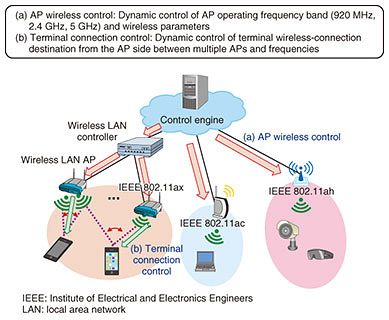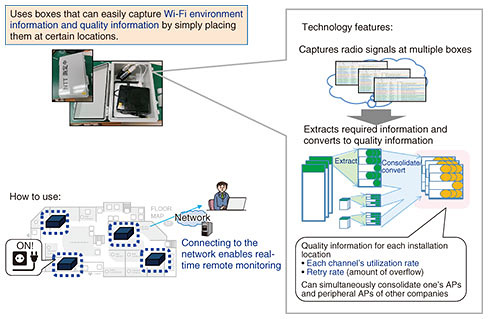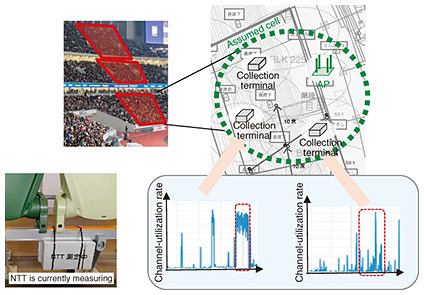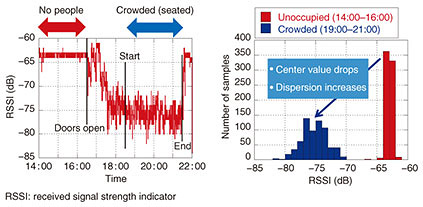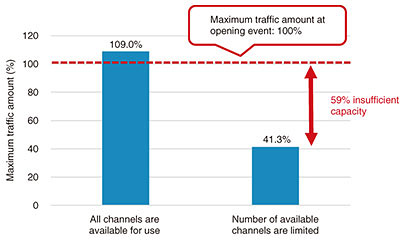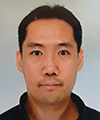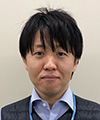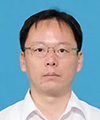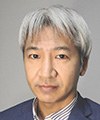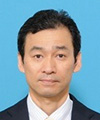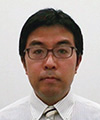 |
|||||||||||
|
|
|||||||||||
|
Feature Articles: Olympic and Paralympic Games Tokyo 2020 and NTT R&D—Technologies that Supported Tokyo 2020 Games Vol. 20, No. 1, pp. 85–90, Jan. 2022. https://doi.org/10.53829/ntr202201fa14 High-efficiency Wi-Fi TechnologiesAbstractNTT undertook the technical development and implementation of high-efficiency Wi-Fi technologies to provide spectators and related personnel a stress-free wireless communications environment at the Japan National Stadium and other venues of the Olympic and Paralympic Games Tokyo 2020. These technologies are expected to lead to new sports-viewing styles using the network of a venue and a variety of new services using a flexible network at events such as meetings, incentives, conferences, and exhibitions (commonly referred to as MICE). Keywords: high-efficiency Wi-Fi, wireless resource control technology, wireless quality visualization technology 1. IntroductionEveryone’s lifestyle has been changing along with the widespread use of smartphones and social networking services (SNSs), and the way in which people participate in events such as when attending sports matches or live concerts has likewise been changing. For example, it has become common for spectators at a venue to take photos or video of an exciting scene using their cameras or smartphones and immediately post such images simultaneously on SNSs or upload them to a cloud environment. In a similar manner, it was envisioned that many spectators at venues of the Olympic and Paralympic Games Tokyo 2020 would be simultaneously using the networks of these venues. The Japan National Stadium, the main venue of the Tokyo 2020 Games, required a stress-free communications environment for spectators appropriately linked to a variety of systems to become a world-class stadium as the new hub for sports in Japan. To this end, specialists having high technical competence through extensive experience in constructing Internet Protocol (IP) networks, Wi-Fi* systems, etc. were recruited from NTT Group companies to set up an information-and-communication-technology environment on a world-class level. These specialists used their diverse experience and expertise in constructing and operating Wi-Fi systems at large-scale stadiums to achieve an optimal arrangement of access points (APs) tailored to the construction and shape of the Japan National Stadium. This arrangement featured an AP for every 70 seats and provided coverage of areas where people would tend to gather such as concourses, vendor stalls, and ticket counters. The end result was a total of approximately 1300 APs, making for a high-density, world-class Wi-Fi system. To achieve such a high-density configuration, optimal channel settings to avoid radio-wave interference and tuning performed at the final stage of construction were important. Therefore, it was decided to use the high-efficiency Wi-Fi technologies being developed by NTT laboratories to create a stable and high-quality Wi-Fi environment. This provided smooth connections to the Internet enabling everyone in the stadium to share their feelings or impressions on SNSs or elsewhere.
2. Introduction to high-efficiency Wi-Fi technologiesThe following introduces high-efficiency Wi-Fi technologies for achieving a stable and high-quality Wi-Fi environment. 2.1 Wireless resource control technologyThe wireless resource control technology derives an optimal combination of Wi-Fi parameters such as the operating frequency channel, bandwidth, and transmission power of each AP depending on the radio-interference conditions among multiple APs (Fig. 1) [1]. It derives, in particular, an optimal channel combination that avoids interference between APs through iterative optimization processing using a genetic algorithm. Carrying out this processing dynamically enables the parameters of each AP to be controlled in accordance with changes in the environment.
2.2 Wireless quality visualization technologyThe wireless quality visualization technology estimates the degree of congestion under peripheral wireless conditions by listening to and analyzing control signals radiated in an area through the use of monitoring devices (boxes) installed at locations near APs or users (terminals) [2]. This technology makes it possible to estimate the positions of transmitting/receiving terminals, issue alerts in the event of a sudden increase in traffic, and provide an operator with user-vicinity information needed to clarify the cause of network instability (Fig. 2).
3. Demonstrations at venuesThe opening event for the new Japan National Stadium was held in December 2019 immediately after completion of the structure. Filled to capacity with 64,000 spectators, the stadium hosted a program that included relay races by famous athletes and live performances by popular artists. During these activities, there were moments when images and video taken by spectators were simultaneously posted to SNSs or emailed throughout the world. Through this event, it was shown that 64,000 spectators could simultaneously make SNS postings without problems as an extension of their everyday life and that the communications infrastructure of the Japan National Stadium could provide stable and high-quality connections. This opening event provided an ideal opportunity to determine changes in the wireless environment and shifts in traffic for an actual high-density gathering of spectators. With the wireless quality visualization technology, the analysis of wireless-environment data that were collected widely and continuously confirmed that traffic could be accommodated without problem during peak traffic occurrences even from the viewpoint of data communications (Fig. 3). Analysis based on data collected using this technology clarified the effects of human-body shielding with respect to receiving radio waves in an environment closely packed with spectators (Fig. 4). It has been reported that the shielding and attenuation of radio waves by human bodies in a crowd of spectators in an environment such as the Japan National Stadium can affect wireless communications, but the magnitude of that effect has not been quantitatively clarified. These analysis results provided beneficial data for detailed designs of Wi-Fi parameters using the wireless resource control technology.
This opening event was the first large-scale event in the world to use the 5.2-GHz band, which had not been approved for outdoor use prior to the event. Japan, however, was a prime promoter of worldwide system revisions with respect to this band and achieved a revision of radio regulations allowing its outdoor use in November 2019 just in time for the opening event. As a result of this achievement, NTT received the 31st Radio Achievement Award of the Minister of Internal Affairs and Communications from the Association of Radio Industries and Businesses. With a view to the Olympic and Paralympic Games Tokyo 2020, there was a need for dividing channels into those for spectator use and those for management use at the same stadium. The aim was to ensure a stable level of communications quality for people related to the Tokyo 2020 Games and actual sports events even during the occurrence of large volumes of traffic generated by as many as 60,000 spectators. From the analysis results of the opening event, a test calculation of traffic volumes was conducted beforehand, and it was found that insufficient capacity would occur at an event on the scale of the Olympic Games if the number of available channels was limited [3] (Fig. 5). NTT’s high-efficiency Wi-Fi technologies can dynamically derive an optimal combination of Wi-Fi parameters even with such a limited number of resources. The effectiveness of these technologies was recognized, and it was decided to provide them at the Japan National Stadium. Unfortunately, it was decided to hold the Tokyo 2020 Games without spectators, so Wi-Fi for spectators was switched off and these technologies were not used at the Japan National Stadium. However, they were used in the free Wi-Fi environment at the Tokyo Big Sight Aomi Exhibition Halls that became the showcase venue for sponsors of the Tokyo 2020 Games. It contributed to the provision of a stress-free wireless environment at this location.
4. Toward the futureAt NTT, we have been researching and developing high-efficiency Wi-Fi technologies to optimize the network within a venue and provide stable throughput with an eye to creating new viewing styles and new types of events. For example, these technologies will enable the flexible allocation of communication resources in accordance with network demand per unit area and the provision of flexible networks that can improve throughput at particular locations such as premium seating and press galleries. These wireless technologies have been given the group name Cradio® [4], which we will continue to research and develop toward the implementation of the Innovative Optical and Wireless Network (IOWN) vision promoted by NTT.
NTT is an Olympic and Paralympic Games Tokyo 2020 Gold Partner (Telecommunication Services). References
|
|||||||||||

